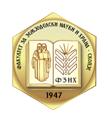REVIEW OF THE GOAT SECTOR IN THE REPUBLIC OF NORTH MACEDONIA: DISTRIBUTION, FARM SIZE, BREED STRUCTURE AND MILK PRODUCTION CAPACITIES
Keywords:
goat, farm size, breed structure, regional distributionAbstract
Goat sector is livestock branch that has its own specific unique history. Еxtensive to semi-extensive breeding system is the most prevalent in the country with moderate level of milk production. Recognition of the importance of goat breeding can be noted by continuous state support in the goat breeding. Variation of national goat flock is present with appearance of ascending and descending trends. There is a decrease in the number of farms, especially farms that breed from 1 to 5 and from 6 to10 heads, but also an increase in the number of heads per farm, especially on farms with size from 25 to 50 and from 51 to 100. Most prevalent goat breeds in the country is Balkan goat (47.51 %). Different distribution of goat breeds is recorded in the country regions, East and Southeast region are leading regions in goat breeding. Raw milk production is in the range from 13584 t in 2015 up to 22864 t in 2018. Moderate milk yield per goat is present, the highest in 2011 (298 litres) and the lowest in 2015 (243 litres). Average purchase price of raw goat milk ranged between 0.29 and 0.31 euros/per litre in the period 2013-2019, which istwice less than the purchase price in EU countries. The improvement and utilization of the genetic capacity of the goat breeds, improvement of farming and feeding practices and continuous state support, education and research, as well as better organization of the farmers can be pointed out as general recommendations for improvement of the sector.



